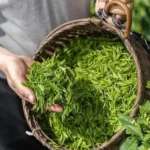In Vietnamese culture, tea drinking is not just a habit but an art of living. While dried tea leaves offer a robust and ancient flavor, fresh tea leaves bring a refreshing, gentle, and natural experience. However, to brew non-bitter fresh tea with clear green liquor that retains its aroma and doesn’t turn reddish when left to stand, you need to master the following secrets. This article will share the ultimate tips, from leaf selection to brewing techniques, enabling you to fully appreciate the delicacy of fresh tea.
1. Select fresh tea leaves the right way
The first and most crucial step to brewing delicious tea is choosing the right leaves. Ideal fresh tea leaves should be:
- Mature yet tender (neither too old nor too young), vibrant green, free from pests and diseases, and without any yellowing.
- If picking directly: opt for early morning harvests when the leaves are still dewy and haven’t been exposed to sunlight, which can reduce their essential oils.
- If purchasing from a market: select bunches of tea that retain their natural fragrance, with intact, unbruised leaves, and free from strange odors.
Note: Avoid using leaves harvested a long time ago. Tea leaves picked within 24 hours are the most flavorful, as they retain their aroma and are less likely to make the tea cloudy or turn reddish.

2. Rinse tea leaves properly for cleanliness and aroma preservation
Fresh tea leaves may carry dust, pollen, or pesticide residues (unless they are organic), so thorough rinsing is necessary without vigorous scrubbing.
The correct way to rinse:
Soak the tea leaves in clean water for about 2–3 minutes, then gently rinse handfuls of leaves under running water.
Drain and let them air dry slightly to avoid excessive moisture diluting the flavor during brewing.
Optionally, you can use a diluted salt solution for rinsing if you have safety concerns, followed by a thorough rinse with regular water.
3. Infuse with water just off the boil – avoid 100-degree Celsius water
This is the key to achieving clear green tea without bitterness. Fresh tea leaves are sensitive to temperature. Pouring boiling water (100°C) on them will “burn” the leaves, resulting in bitterness and a quick transformation to a reddish-brown color.

Ideal temperature: approximately 75–85 degrees Celsius.
Suggested brewing method:
Boil water and let it cool for about 5–7 minutes before pouring it into the teapot.
If using a dedicated tea brewing pot (glass, ceramic, or clay), preheat it by rinsing it with hot water to warm the pot before adding the leaves.
4. Secrets to maintaining clear green tea without redness
To preserve the green color of your tea and delay redness, keep the following in mind:
a. Avoid oversteeping: Use a moderate amount of tea leaves. The ideal ratio is about 10–15 grams of tea per 500 ml of water. Oversteeping can lead to rapid oxidation and water discoloration. Consider briefly rinsing and blanching the leaves once before infusing to remove bitter and reddish tannins.
b. Add a twist: A traditional yet little-known trick is to gently squeeze in a few drops of fresh lemon juice or add a few grains of pure white salt to the teapot after brewing. The mild acid from the lemon or salt helps stabilize the tea’s color and slows down oxidation, which causes redness.
c. Avoid frequent opening of the teapot lid: Each time the lid is opened, oxygen accelerates the oxidation process. After pouring the water, keep the lid closed, and avoid stirring or shaking vigorously.
d. Maintain stable post-brewing temperatures: If you plan to let the tea stand for an extended period without turning reddish, pour it into a vacuum flask or glass bottle, allow it to cool, and then seal the container. Avoid exposing the tea to outdoor temperatures or fluctuating environments.
5. Storing fresh tea after brewing:
Freshly brewed tea is best consumed within the day to ensure optimal flavor and appearance. However, if you wish to keep it longer:
Transfer it to a sealed container and store it in the refrigerator’s cool compartment.
Do not keep it for more than 24 hours, even if it hasn’t turned reddish, as it may spoil, lose its aroma, or develop harmful bacteria if hygiene is compromised.
Never reheat fresh tea, as this will degrade its nutrients, flavor, and clarity.
6. Additional considerations when drinking fresh tea
Avoid drinking tea on an empty stomach: It may cause stomach discomfort and a cold sensation.
Refrain from drinking tea immediately after meals: Tea may interfere with iron and protein absorption.
Do not consume tea left overnight: Prolonged exposure not only diminishes its nutritional value but also fosters harmful bacteria that can affect your digestive system.
3 Ways Chamomile Tea Can Help You Sleep Like a Baby
Introducing the ultimate remedy for sleepless nights – a cup of chamomile tea. Its delicate fragrance and natural sedative properties make it the perfect bedtime companion, helping you drift off into a peaceful slumber. With its calming effects, this tea is a natural solution for those struggling to find a good night’s rest.
The Forgotten Flower: A Tasty Treat for the Urban Forager
The Northwest is renowned for its majestic landscapes and unique culinary delights. Among these delights is the Ké flower, a forest flower with a distinct bitter taste that has captivated the palates of discerning food enthusiasts. This exotic ingredient may not be an easy flavor to acquire, but those who acquire a taste for it become enamored with its allure, eagerly anticipating its seasonal appearance to indulge in its distinctive flavor once more.






































